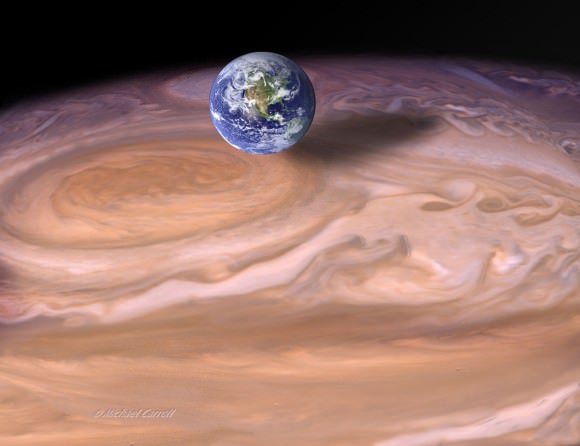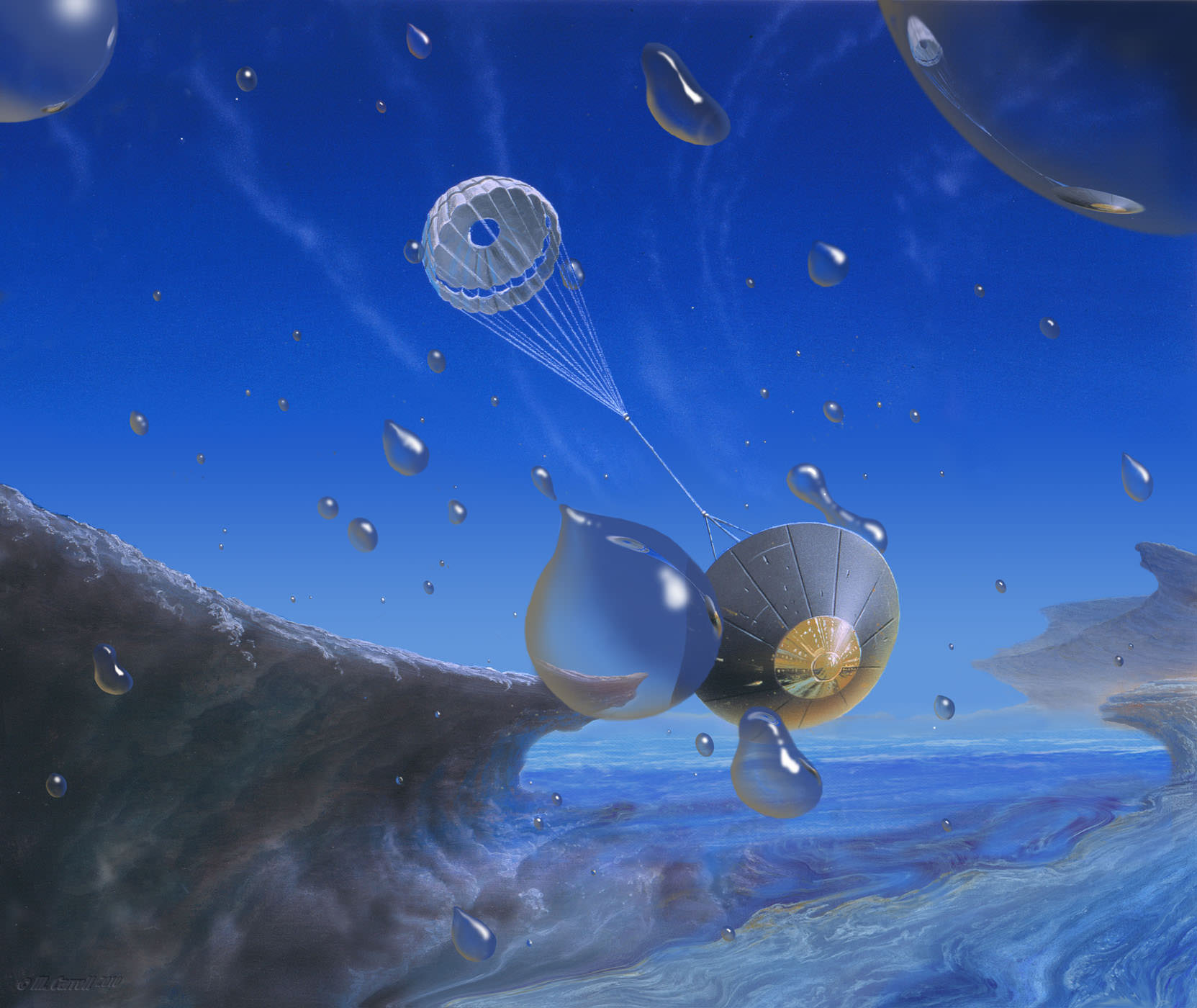[/caption]
Editor’s note: We all want to explore other worlds in our solar system, but perhaps you haven’t considered the bizarre weather you’d encounter — from the blistering hurricane-force winds of Venus to the gentle methane rain showers of Saturn’s giant moon Titan. Science journalist Michael Carroll has written a guest post for Universe Today which provides peek at the subject matter for his new book, “Drifting on Alien Winds: Exploring the Skies and Weather of Other Worlds.”
It’s been a dramatic year for weather on Earth. Blizzards have blanketed the east coast, crippling traffic and power grids. Cyclone Tasha drenched Queensland, Australia as rainfall swelled the mighty Mississippi, flooding the southern US. Eastern Europe and Asia broke high temperature records. But despite these meteorological theatrics, the Earth’s conditions are a calm echo of the weather on other worlds in our solar system.
Take our nearest planetary neighbor, Venus. Nearly a twin of Earth in size, Venus displays truly alien weather. The hurricane-force Venusian winds are ruled not by water (as on Earth), but by battery acid. Sunlight tears carbon dioxide molecules (CO2) apart in a process called photodissociation. Leftover bits of molecules frantically try to combine with sulfur and water to become chemically stable, resulting acid hazes. Temperatures soar to 900ºF at the surface, where air is as dense as the Earthly oceans at a depth of X feet.
Venus is the poster child of comparative planetology, the study of other planets to help us understand our own. Earth’s simmering sibling has taught us about greenhouse gases, and gave us an even more immediate cautionary tale in 1978. The Pioneer Venus orbiter discovered that Venus naturally generates chlorofluorocarbons (CFCs) in its atmosphere. These CFCs were tearing holes in the planet’s ozone. At the same time, a wide variety of industries were preparing to use CFCs in insecticides, spray paints, and other aerosol products. Venus presented us with a warning that may have averted a planet-wide crisis.
In the same way, Mars has provided insights into long-term climate change. Its weather is a simplified version of our own. Locked within its rocks and polar caps lie records of changing climate over eons.

But fans of really extreme weather must venture further out, to the outer planets. Jupiter and Saturn are giant balls of gas with no solid surface, and are known as the “gas giants.” They are truly gigantic: over a thousand Earths could fit within Jupiter itself.
The skies of Jupiter and Saturn are dominated by hydrogen and helium, the ancient building blocks of the solar system. Ammonia mixes in to produce a rich brew of complex chemistry, painting the clouds of Jupiter and Saturn in tans and grays. Lightning bolts sizzle through the clouds, powerful enough to electrify a small city for weeks. Ammonia forms rain and snow in the frigid skies. Jupiter’s Great Red Spot is a centuries-old cyclone large enough to swallow three Earths. Saturn has its own bizarre storms: a vast hexagon-shaped trough of clouds races across the northern hemisphere. Over the south pole, a vast whirlpool gazes from concentric clouds like a Cyclops.

Beyond Jupiter and Saturn lie the “ice giants”, Uranus and Neptune. These behemoths host atmospheres of poisonous brews chilled to cryogenic temperatures. Methane tints Uranus and Neptune blue. Neptune’s clear air reveals a teal cloud deck. Hydrocarbon hazes tinge Uranus to a paler shade of blue-green. Neptune’s clear air is somewhat of a mystery to scientists. This may be because cloud-forming particles can’t stay airborne long enough to become visible clouds. Some scientists propose that Neptune’s abundant methane rains may condense so rapidly that within a few seconds tiny methane raindrops swell to something the size of a beachball. There are no clouds adrift, because methane rains out of the atmosphere too quickly.
One of the strangest cases of bizarre weather comes to us from Neptune’s moon Triton. Triton’s meager nitrogen air is tied to the freezing and thawing of polar ices, also composed of nitrogen. Triton’s entire atmosphere collapses twice a year, when it’s winter on one of the poles. At that time of year, all of Triton’s air migrates to the winter pole, where it freezes to the ground. The moon only has “weather” during the spring and fall; its atmosphere exists only during those seasons.
So, the next time you contemplate complaining about the heat, think of Venus. And if it’s blizzards you worry about, find comfort in Triton: at least our atmosphere doesn’t disappear in winter!
For more on the subject, see Michael Carroll’s newest book, Drifting on Alien Winds: Exploring the Skies and Weather of Other Worlds from Springer.


Contrary to popular renditions, raindrops do not have the teardrop shape when falling. They have more a bowl shape. Of course I can’t say how huge drops of methane might appear on Neptune, but I suspect the shape might be similar.
LC
Indeed. According to Wikipedia: “The classic shape associated with a drop (with a pointy end in its upper side) comes from the observation of a droplet clinging to a surface. The shape of a drop falling through a gas is actually more or less spherical. Larger drops tend to be flatter on the bottom part due to the pressure of the gas they move through.”
You’re correct. The shape of a falling raindrop depends on its size, but it never takes the shape of a pointed teardrop. Small drops are mostly spherical. As they get larger, they become more ellipsoidal, with the long axis oriented horizontal. The largest drops are shaped more-or-less like hamburger buns. Eventually, at about 1 cm in diameter (measured horizontally), the drop becomes unstable due to turbulence of the air flowing around them, and they break apart into smaller drops. The maximum size allowed thus depends on aerodynamic effects, which in turn depends on the terminal velocity and air density. It would be an interesting study to see what range of atmospheric/local gravity conditions would allow for particularly large drops.
As for other types of liquids, I imagine, as you also suspect, that the same basic transition would happen, but at different diameters due to differing values of surface tension, etc.
At the risk of being unpopular with some folks, given the large budget requirements for these types of missions I find the science here to be somewhat dubious. I am sure the outer Neptunian gas giants have some interesting secrets, but I do not see them as foundational. In other words, space missions meant to put radio interferometers in space, or detect gravity waves or to map the CMB to even greater precision to get non-Gaussian signatures of the earliest cosmos would get my thumbs up any day over a mission to place a spacecraft in the orbit of Neptune. The same would go for a very expensive mission to place a heat resistant rover on the surface of Venus. I am at best tepid towards ideas of placing probes or rovers on Europa to probe for the putative ocean in its depths.
LC
Disagree very strongly regarding the Venus rover. I see any study of Earth’s twin planet as critical because it increases our understanding of Earth itself- particularly since we’re worrying about a greenhouse effect here. Maybe you just mean that a lander is wasteful compared with orbiters. I don’t know. I can see the appeal of something like a sample-return effort.
I think Mars is maybe a closer analogue of Earth, at least with respect to atmospheric conditions. There might even be life there, where Martian biology might exist under the regolith. Sending probes which can probe the subterranean geology of Mars and that have an automated biology lab bench would be worth the effort.
A long lasting probe or rover on Venus would have to be constructed like a deep ocean submersible, but with ceramic components on it outer shell. It would be a massive affair, and the costs would expand proportionately. The rover would also require a hefty heat pump and an adequate power supply to run it to keep critical components from being subjected to the autoclave temperatures there. This would not be technically easy to accomplish, nor would it come cheap.
A return mission is of course interesting. However, this is also a very challenging thing to accomplish. For one it is best if the gravity of the planet is not very large. Mars has about half Earth’s gravity acceleration at its surface. A vehicle that can reach escape velocity from its surface would need to reach about 7km/sec. This is comparable to launching a modest sized launch vehicle, such as Scout rocket, from the Martian surface. Of course this first requires getting this launched to Mars and properly secured on the Martian surface. The landing vehicle would serve as the launch pad with all of those requirements. To make the samples returned interesting it is best to have a rover accompany this to get samples from different places. Some thought should indicate this is a very non-trivial space mission. There are some plans in the works for something of this sort, but I think it has some budgetary issues and Congress these days is not predisposed to such huge expenditures.
A sample return from Venus would be an incredible endeavor. The gravity of Venus is comparable to Earth’s, so the launch vehicle which sends samples back would have to be very hefty, a bit like launching a Delta rocket. Further, launching such a rocket from an environment that is 550deg C and 100 Torr presents enormous challenges. That will not happen any day soon, if at all.
My main point is that these would be huge expenditures to study what ultimately amounts to a very tiny part of the universe as a whole. We are of course find a whole gaggle of planets out there, and so what we have here is just a parochial slice of the picture. Earth is of course important, largely because we are pretty much bound to it. However, when taken in its broadest perspective there is a whole lot more to the universe than the geology of Venus.
LC
Mission profile assumptions are tricky. Most likely a planetary return mission would work like Apollo, going to orbit first, then docking with a mothership containing the fuel to get home. A Venus return would probably need to launch to orbit from the more temperate higher atmosphere, getting there by balloon.
In any case, the planets will always be waiting for us when more advanced, cheaper technology is invented. Chemical rockets are so 1930’s.
A Venus return mission would be enormously complex and expensive. Even if there is a return mother ship in orbit around Venus, the launch vehicle deployed from the surface would have to be comparable to a launch vehicle which sends a satellite into orbit around Earth. The gravity of Venus is comparable to Earth gravity. There is also the problem of deploying this from the surface of a planet with 600-deg C atmosphere at 100atm pressure. I would suggest that this would be a very difficult and expensive mission to accomplish.
LC
It´s necessary to send many micro-spacecraft each planet to advance knowledge of the extraterrestrial environment.
Why is an artist’s conception of a probe entering Neptune’s atmosphere referred to as a “Triton probe”? Triton is a moon of Neptune. A Triton probe would be entering Triton’s atmosphere, not Neptune’s atmosphere.